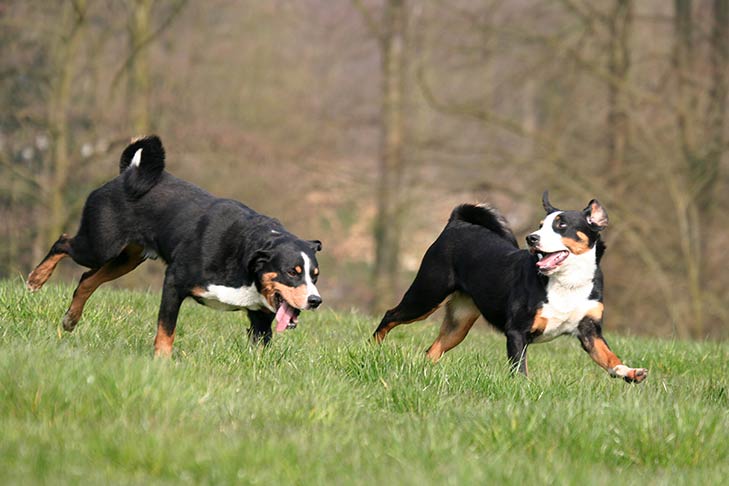
- sennenhunde
- bernese mountain dog
- greater swiss mountain dog
- appenzeller sennenhund
- entlebucher mountain dog
Four breeds known as Sennenhunde—the Bernese Mountain Dog, Greater Swiss Mountain Dog, Appenzeller Sennenhund, and Entlebucher Mountain Dog, originally accompanied Alpine herdsmen and dairymen called “Senn” or “Senner” on their daily duties in the Swiss Alps. Hund comes from the German word for dog, and Sennenhund means “dog of the Senn.”
Translating to Swiss mountain dogs or Swiss cattle dogs in English, these all-around farm dogs willingly performed any task their owners asked. These breeds guarded the family and herd or flock from menacing wolves and large predators.
Possibly descended from heavy-boned, large shepherd dogs known as Roman molossers and later crosses with the Saint Bernard dog from ancient Epirus, the Sennenhunde today are medium to large dogs with muscular legs and giant paws that grip deep snow. Their distinctive double-layered tricolor coats help insulate them against the coldest winters.
Intelligent dogs who are dependable, and faithful, the Sennenhunde are devoted and beloved family companions at home and thrive on keeping busy and performing tasks for their owners. In the U.S., the Bernese Mountain Dog is the most popular Sennehund, with the other three breeds gaining a growing list of admirers. In Europe and Switzerland, the working quartet is well known.
The Bernese Mountain Dog and the Greater Swiss Mountain Dog belong to the American Kennel Club’s Working Group, while the Entlebucher Mountain Dog is part of the Herding Group. The Appenzeller Sennenhund, a herding breed, is enrolled in the AKC Foundation Stock Service (FSS).
Each breed exhibits a solid work ethic, loyalty, and a loving personality. Which dog is a perfect fit for you?
Bernese Mountain Dog
2,000 years ago, Roman soldiers crossed the Alps to invade what’s now Switzerland with the ancestors of the Bernese Mountain Dog and the other Sennenhunde. These canines helped pull carts loaded with army supplies heavier than their weight, herded cattle that fed the troops and guarded the encampment. Later, these black-and-tan dogs bred with Mastiff-type dogs and produced today’s Bernese Mountain Dog.

The earliest record of Berners appears in the midland region of Switzerland near Bern as it evolved into an agricultural area of dairy production. Farmers and basket weavers relied on the Bernese Mountain Dogs to pull heavy carts up and down the Alps. A wagon load consisted of bulky cheese rounds and four to six metal milk cans, each weighing 80 pounds when filled with ten gallons of milk or piled high with fabrics. The dogs occasionally herded and drove small groups of cattle. When industrial methods replaced the need for canine labor, the number of Bernese Mountain Dogs began to decline.
The first pair of Berners, “Felix” and “Fridy” came to the United States in 1936, and a year later, the AKC recognized the breed. The Bernese Mountain Dog Club of America (BMDCA) was formed in 1968. The club established a drafting and carting program to maintain and test the breed’s historic working ability. The BMDCA’s draft tests develop and demonstrate the Berner’s natural skills to work as a draft dog. This test evaluates how well the dog can accept a harness and its comfort level when hitched to a draft rig—a sled, toboggan, or travois—a frame slung between trailing poles bearing a load.
“Over the last 30 years, the breed’s popularity has surged,” says Georgeann Reeve, former president of the BMDCA. “Credit their companionship, loyalty, and working ability. They’re biddable and up for trying any new dog sport, but pulling a cart is second nature to them.”
Similar in appearance to the other Sennenhunde, the Bernese Mountain Dog and the Greater Swiss Mountain Dog are the largest of these four breeds. When measured at the shoulder, a Berner male stands 25 to 27.5 inches tall, while the female is 23 to 26 inches tall.
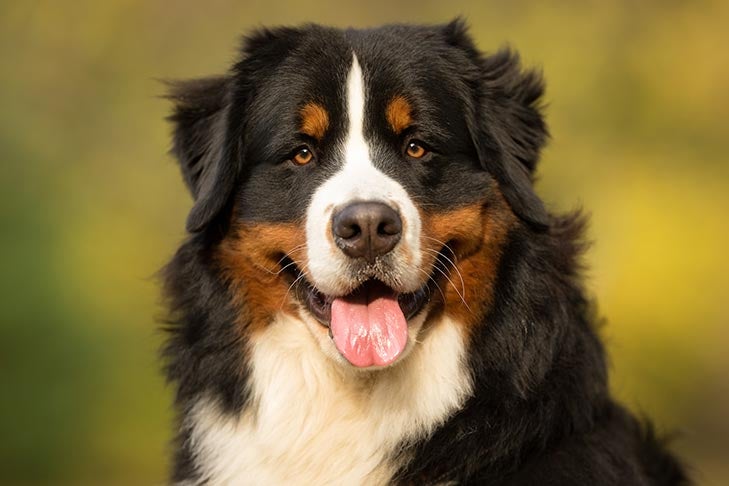
Like social butterflies, Berners like strangers and are gentle and compliant. They don’t require as much exercise as a Swiss Mountain Dog or a Saint Bernard, but they need regular outings for physical and mental well-being. They’re happy going on long walks outdoors in harsh, low temperatures. In warmer weather, these dogs are content with small amounts of exercise.
The Berner’s weather-resistant coats protect them from rainy and snowy weather in cold climates. Of the four Sennenhunde, this is the only breed with a moderately long and silky coat, which can be either slightly wavy or straight.
Greater Swiss Mountain Dog
Oldest of the Sennenhunde, the Greater Swiss Mountain Dog descends from Mastiff-type dogs brought over the Alps by Roman soldiers who used them to support their war campaign. A component breed of the Saint Bernard and Rottweiler, these dogs later worked in Switzerland as farm and pasture assistants. The Swissies hauled heavy loads of dairy and meat to market and performed herding and guarding tasks.
Farmers, herders, and merchants in Central Europe used the early Greater Swiss Mountain Dog’s ancestors in the 19th century. As a breed, the Swiss Mountain Dog’s popularity in Europe grew slowly. During World War II, the Swiss Army used the Swissy to haul wagons.
“A sentry breed, Swissies were involved in all farm activities and alerted their owners to anything or anyone who didn’t belong there,” says Judge’s Education Chair Anna Wallace of the Greater Swiss Mountain Club of America. “The dogs didn’t pursue an intruder but alerted their owner.”
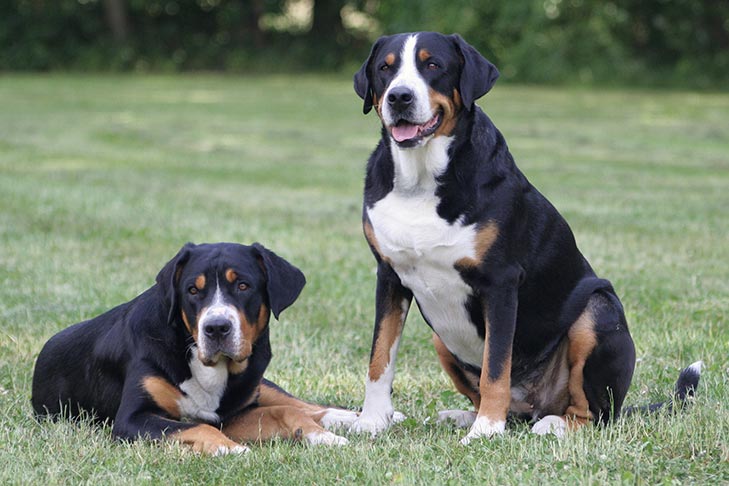
According to Wallace, Swissies maneuver dairy cattle to and from the barn. This breed can herd, but it is less efficient than an Entlebucher Mountain Dog or an Appenzeller Sennenhund. “At feeding time, a Swissy will block cattle from trampling the farmer.”
How does the Swissy differ from the other Sennenhunde? “All four Sennenhunde are alert dogs, but warning the owner and pulling a cart are the Swissy’s main occupations,” Wallace says.
Pack Hiking is a popular event at the Greater Swiss Mountain Club’s national show. In this event, the dog carries a backpack weighing 20 percent of its body weight. Another event is Weight Pulling, where the dog pulls a cart weighing a few thousand pounds.
The Greater Swiss Mountain Dog came to the United States in 1968 and was fully AKC-recognized in 1995. When measured at the shoulder, the Sennenhunde’s largest (or the ‘greater’) is a Swissy male, who stands 25.5 to 28.5 inches tall, while the female is 23.7 to 27 inches tall.
The short, smooth black, red, and white double coat is low maintenance. It sheds twice a year and requires regular bathing and brushing to look its best. Healthy upkeep includes regular nail trimming and cleaning ears and teeth.
Entlebucher Mountain Dog
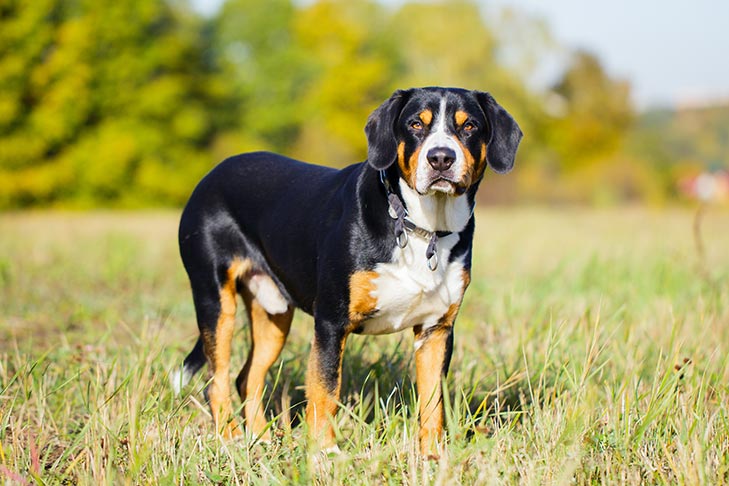
The Entlebucher Mountain Dog, or ‘Entle’ for short, is named for its place of origin—Entlebuch in central Switzerland. This agricultural area produced dairy, fruit, cheese, and meat.
Medium-sized and the smallest of the four Sennenhunde, Entlebucher males are 17 to 21 inches tall, and females range from 16 to 20 inches tall. Entles excel as physical herders who use their bodies to maneuver cows.
“They’re not great at carting because they’re smart and want to reinvent the system,” says Wallace, who also breeds Entlebuchers. “In Switzerland, the breed’s nickname is ‘the laughing dog’ because it wants to make you laugh at its antics—like the class clown.”
As farm and family dogs with a strong work ethic and remarkable balance and agility, Entles accompany Alpine herders in Switzerland. An athletic and enthusiastic breed, Entles lead a small herd of a dozen dairy cattle up the Alps in Summer and bring the herd down into the valley in Fall.
“While climbing the mountains, the cows travel treacherous, narrow paths along the cliffs,” Wallace says. “Close herders, the Entles walk the edge to keep the cows from falling off the cliff. The dogs do a lot of leaping and headbutting the animals to nudge them along.”
Entles are devoted to their families when not herding dairy cattle and enjoy active dog sports.
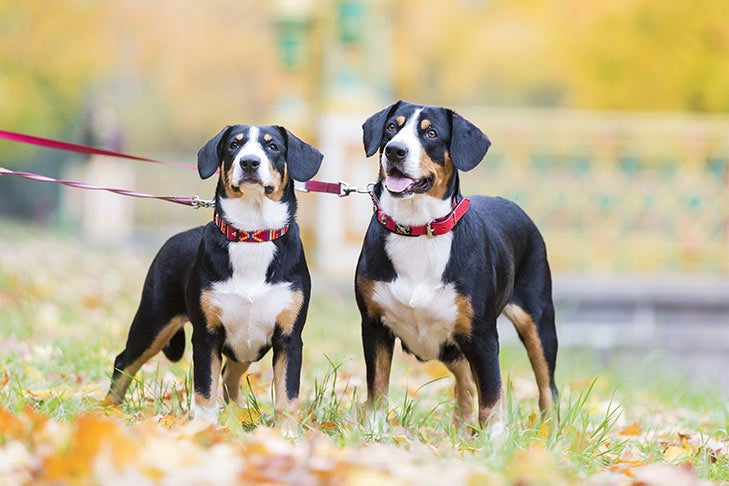
“At the end of the day, Entles will relax near their owners,” Wallace says. “Historically, they lived in the house with the farmer and weren’t kept in the barn.”
The first Entle came to the United States in 1975. The AKC named the National Entlebucher Mountain Dog Association (NEMDA) as an AKC Parent Club in 2008. The breed received full AKC recognition in 2011.
The Entle’s short, dense, shiny coat is tighter than a Greater Swiss Mountain Dog’s but requires care. To minimize shedding, brush the coat with a thick bristle brush. Regular nail trimming, dental care, and ear cleaning help keep an Entle in good condition.
Appenzeller Sennenhund
The third-largest breed of the Swiss Mountain Dog family, the Appenzeller is a rare breed listed with the AKC’s Foundation Stock Services (FSS). Recognized in Europe for over 100 years, the breed’s origin is the Appenzell region of Switzerland. Once known as the Appenzell Cattle Dog, the breed was first described in 1853 as a “high-pitch, barking, short-haired, medium-sized, multicolor dog of a quite even Spitz type. Used partly to guard the homestead and herd cattle.”

Breeding Appenzellers began in Switzerland in 1898. Today’s Appenzeller is a highly intelligent herding dog seen throughout Switzerland. This dog likes to problem-solve and complete a task. The breed can pull a cart and herd dairy cattle by nipping at their heels.
The Appenzell Mountain Dog Club of America (AMDCA) is the official national breed club.
Male dogs are 20.5 to 22 inches tall, and females are 19.5 to 21.25 inches. The breed is black, tan, and white. Sometimes Havana brown rather than black is the base color with rust and white markings.
With a firm, short, double coat, Appenzellers require weekly brushing with a firm brush to remove loose hair. Regular nail trimming and dental and ear care keep this dog in good condition.

